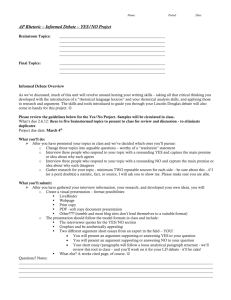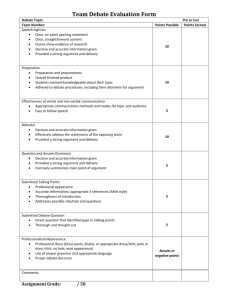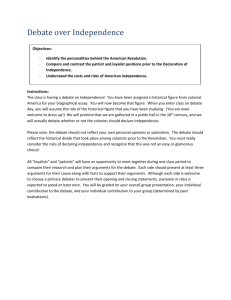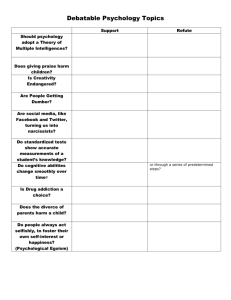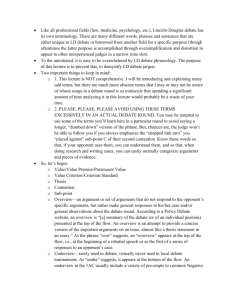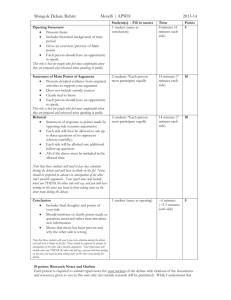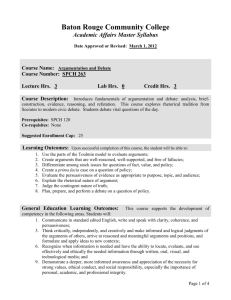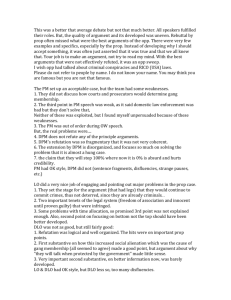Peer training and learning ideas.doc
advertisement
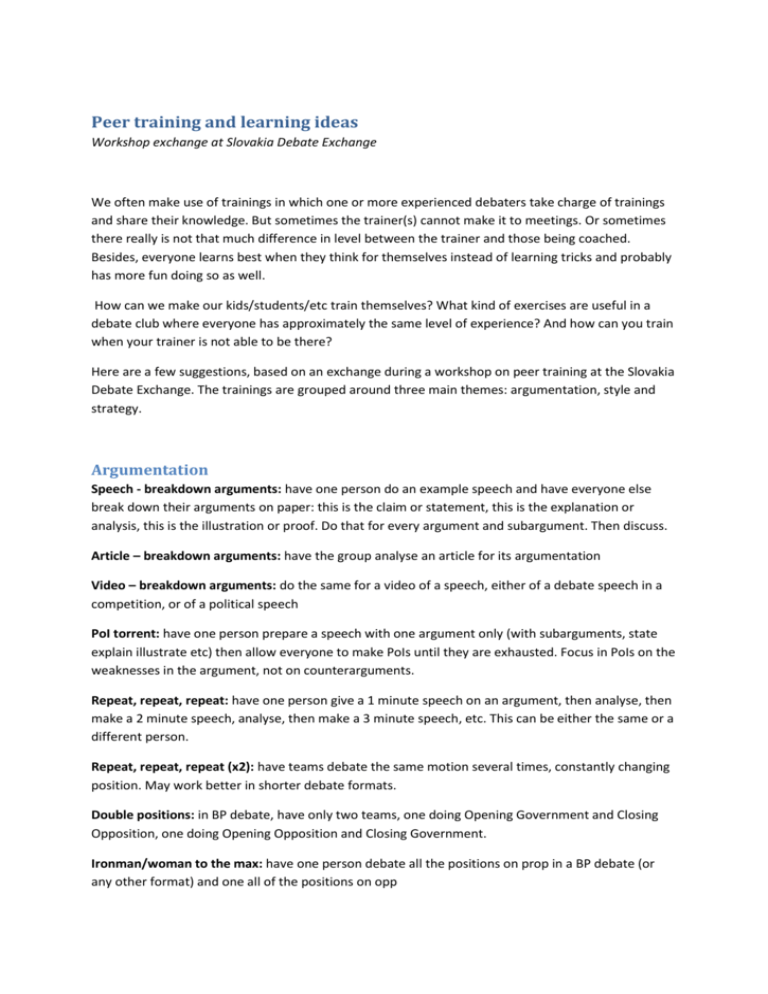
Peer training and learning ideas Workshop exchange at Slovakia Debate Exchange We often make use of trainings in which one or more experienced debaters take charge of trainings and share their knowledge. But sometimes the trainer(s) cannot make it to meetings. Or sometimes there really is not that much difference in level between the trainer and those being coached. Besides, everyone learns best when they think for themselves instead of learning tricks and probably has more fun doing so as well. How can we make our kids/students/etc train themselves? What kind of exercises are useful in a debate club where everyone has approximately the same level of experience? And how can you train when your trainer is not able to be there? Here are a few suggestions, based on an exchange during a workshop on peer training at the Slovakia Debate Exchange. The trainings are grouped around three main themes: argumentation, style and strategy. Argumentation Speech - breakdown arguments: have one person do an example speech and have everyone else break down their arguments on paper: this is the claim or statement, this is the explanation or analysis, this is the illustration or proof. Do that for every argument and subargument. Then discuss. Article – breakdown arguments: have the group analyse an article for its argumentation Video – breakdown arguments: do the same for a video of a speech, either of a debate speech in a competition, or of a political speech PoI torrent: have one person prepare a speech with one argument only (with subarguments, state explain illustrate etc) then allow everyone to make PoIs until they are exhausted. Focus in PoIs on the weaknesses in the argument, not on counterarguments. Repeat, repeat, repeat: have one person give a 1 minute speech on an argument, then analyse, then make a 2 minute speech, analyse, then make a 3 minute speech, etc. This can be either the same or a different person. Repeat, repeat, repeat (x2): have teams debate the same motion several times, constantly changing position. May work better in shorter debate formats. Double positions: in BP debate, have only two teams, one doing Opening Government and Closing Opposition, one doing Opening Opposition and Closing Government. Ironman/woman to the max: have one person debate all the positions on prop in a BP debate (or any other format) and one all of the positions on opp Infosheets: before each debate evening, have a short presentation in which one person presents an infosheet (s)he prepared for that meeting. Debate something related to the infosheet, but not solely about it (to learn how to use facts). Duty rotates. Presentation: each student presents something about their area of expertise that could be useful in debate (be it atomic energy facts, workings of the EU, effect of Keynesian policies, etc) – then do a motion about this topic. Open motions: so the opp does not know what to expect from prop and needs to learn to react on the spot Why?: have one debater give speech. Whenever someone does not understand the basis for the argument, they can rise and ask why Group prep: Do a group prep of a motion for prop and opp. Pick some very difficult ones and spend say an hour on one. Then do some other difficult ones and see if you can do them in ten minutes. Style First a few exercises on getting over speaking nerves. Then some on getting rid of ticks. Lastly, how to improve style. Just stand there: have someone stand in front of the group for half a minute. Pineapple: have everyone debate to a judge that is a pineapple instead of a person. They can probably act more self-assured when being stared at by a public of people. Look at me: wave at a person if you feel neglected for longer than (say) 30 seconds Group mirror: a person who has a particular tick, is mirrored by the whole group as they perform the tick Video: tape the speech (sound and images) and have person look at their ticks Tape: tape the speech (sound only) and have the person listen to their use of uhm, stopping words, repetitions etc. Also have the person listen to style things Examples: do a group think on what are good examples for arguments. Analyse famous speeches: as a group, watch famous speeches and determine what makes them work. Emotional reading: read a text with a certain emotion. Emotional speech: perform a speech from a certain emotion. Then do so from another emotion. Let your voice do the talking: do speeches in which you speak quickly, or slowly, speak softly or loudly, use lots of intonation or speak monotonously. Thereby get the feeling of what happens when you do this. Strategy Many of the examples used on the argumentation side are also relevant for strategy (and vice-versa). For example, the repeat debates and the group prep of motions allow for testing strategies as well as arguments. “Slow debates:” have debater present one argument and analyse with the group how relevant that is for the debate – then choose another argument Carding: have one argument per card, have judge move card to the side that wins the argument. At the end of the debate, each time will have a few cards that are closest to them, those arguments they won or contributed strongly to. Determine as a group which were the more important arguments. Response speeches: have one prop speech. Have a speaker do an opposition speech with only rebuttals of the argumentation

